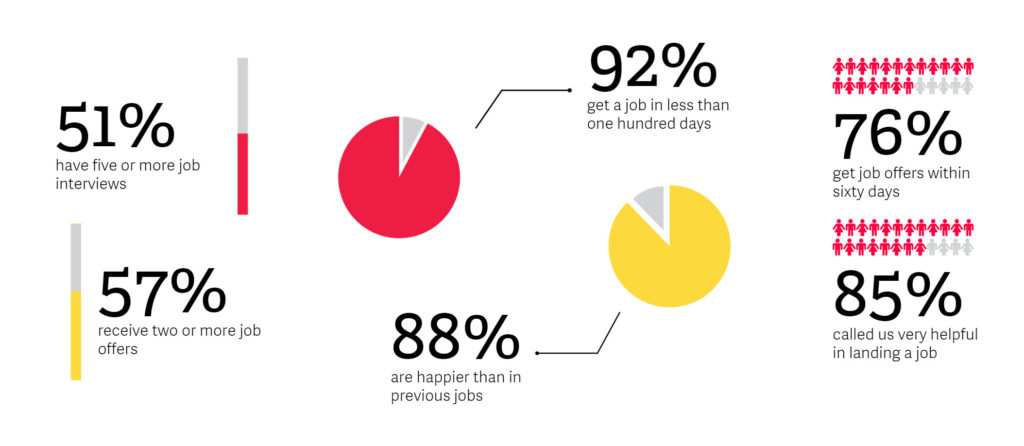Whether you are a job seeker or gainfully employed, the term “career accelerator” seems to be trending these days. And to be honest, I can’t think of any other words that sound so good together (except maybe “free food”).
As a former marketer turned stay-at-home mom, I voluntarily left the workforce, knowing that I wanted to return to work when my son turned 3. In those three years, a lot changed in the world of digital marketing. That combined with the challenge experienced by anyone with a gap in their resumé, I knew I’d have to do things a little differently to get back into the game.
To be honest, I didn’t need much convincing to know that a career accelerator was something I wanted to do. I was lured in by those two promising words and a 3rd person account of a success story from a friend of a friend of a friend’s son who attended Startup Institute. So I decided to apply pretty much on a whim. With promises of a career, skills, network and mindset, not only did it seem like the solution to returning to work, but it was also low-risk (versus an MBA) and efficient (a quick 8 weeks). And if nothing else, at least I would have a foundation for a network in this new city.
So 1 online application, 2 Skype interviews (with possibly the worst video connection ever), and 4 hours later, I was accepted into the Technical Marketing program at Startup Institute starting the following week.
So, what is a career accelerator?
A career accelerator can take many forms, from an 8-week full-time program to part-time evening classes. The point is to give you the skills to advance your career to the next level or to help you make a career change. Students can be at any stage in their career, from the recent graduate, to mid-level management, to people making a career switch after years in another industry.

Typically aimed at those looking to work at startups, a career accelerator is meant to bridge that gap between what you’ve learned in school with the skills that actually apply to that particular industry. For example, you may have taken Comp Sci 200, but did you learn Ruby on Rails or SQL?
In fact, the point of many career accelerators is to create the people they want to work in the industry – serving as an incubator and churning out awesome, innovative people that will contribute to the betterment of the startup community as a whole.
But of course, this is just the theory. Is it actually true in practice? And having completed the program, was it everything I thought it would be?
Expectation: Getting all the relevant skills to push your career to the next level.
Reality: Get exposure to all the relevant skills to push your career to the next level.
There are four tracks that one can study at Startup Institute – Technical Marketing, Sales, Web Design or Web Development, and everyone participates in the core curriculum of culture and emotional intelligence.
I decided to build upon my knowledge of SEO by enrolling in the Technical Marketing program. In my track, our skill levels ranged from recent undergrad to a few who had their own successful businesses. With so many different levels of experience, the “next level” is all relative. While you will gain an understanding of all the important skills needed for a job in your chosen track, the sessions just aren’t long or in-depth enough to push everyone to that next level. And if you are a complete beginner, it may only serve to show you what you don’t know.
Because I had prior experience with SEO, I found our sessions to be informative and interesting. The world of digital marketing changes quickly, and learning from professionals and industry leaders really helped me understand what challenges I might face at my next job. However, for someone without related experience, I imagine that it is difficult to gain a clear sense of how to apply all these marketing techniques.
How to get the most out of it: Try to get a basic understanding of the subjects prior to the sessions and then do all of your pre-work and homework. Ask the instructors questions about what you’ve worked on and the roadblocks you’ve encountered. This is an opportunity to download directly from a subject expert and truly build upon your existing knowledge. It should already be obvious, but definitely take advantage of this.
Expectation: You will instantly get a network.
Reality: You will instantly get a network, but only of your own classmates.
Although Startup Institute stresses the importance of networking in order to find a job, you can’t rely on them for these connections. Networks are not given freely, because the people who have them took a long time to build them up. So if you actually want to be connected with someone, you will need to spend your days finding these people and earning their attention. On occasion, someone will throw you a bone and give you a warm intro, but more often than not, you have to make the effort to do it yourself.
How to get the most out of it: You’ve already made the financial investment, so use this time to get fully immersed in the startup scene. Find industry events and go to all of them – even if you can only stay for a little bit. The best events are NOT the happy hours with free booze. In fact, these are the worst for networking. I’ve found that the best ones are those that are industry specific, have expert panels, or surround a hackathon. Interestingly enough, I have found that the amount of money you are willing to pay directly correlates to the quality of professionals you’ll meet at the event.
One last note on this: Although LinkedIn is a great networking tool, be wary of suggestions to use anything touted as “Tinder for networking.” I learned the hard way and somehow found myself on an unintentional date. I guess as a general rule, anything Tinder is probably not a good idea.
Expectation: Make lots of friends.
Reality: Make lots of friends. Yup, it’s true.
Although everyone in the room comes from different walks of life, you’ll be surprised who you end up being closest to. Who knew that a Jersey mom would become besties with both a free-spirit surfer in his twenties and a member of the first dot com boom?
How to get the most out of it: Have some fun during the program. Yes, it is a stressful 8 weeks, so give yourself a break every now and then and have that beer. And on rare occasion if you can align the goals of the program with having some fun, go for it. (Always say “yes” to Startup Climbing.)

Expectation: You will get a job immediately after the program.
Reality: Per Startup Institute’s website, 92% of students find a job within 100 days. With this statistic it’s easy to expect to get a job immediately after the program ends. This was in fact, not true for my cohort – and only two people were hired upon graduation. 100 days however, in reality, is much longer than it sounds; it’s the equivalent of 14 weeks or almost 3.5 months. And even now, I survey my friends to find that there are still more than 8% looking for their first jobs months after the program has ended. Furthermore, of the ones that did find jobs, a few either went back to their original careers, accepted an internship, or have since moved on from their initial employment.
Well…let’s back up, because this is an important point and the reason why some people are left disappointed with career accelerators.
There are two ways to approach the program; there are those that conduct the job hunt while doing their program and those that start their hunt when the program is over. There is no right way to do it, just a matter of personal preference and bandwidth. (I didn’t start my search till after the program.)
The wrong way to do it though, is to enter the program thinking that just by matriculating into the program the hard work is done, and that the completion certificate gets you a job when you walk out the door. That’s not just unrealistic, but really, really incredibly unrealistic. I mean, think about it, outside of T-ball, does anyone get rewarded just for showing up?
But the point of this is not to rag on those that are still seeking a job; it’s that the statistic is faulty. It takes credit for a lot of jobs that aren’t a direct result of the program, leading you to believe that Startup Institute is responsible for getting 92% of the cohort hired. The truth is, you will eventually get a job somewhere, sometime in the future, and without an A/B test, who is to say that it’s the program and not just your awesomeness?
How to get the most out of it: Take the statistic with a grain of salt, knowing that you are the one who is ultimately responsible for your outcome. Start your job search when it’s right for you, and expect that it can take anywhere from weeks to months. There is a reason why a Google search for “average job search length” comes up with a bunch of vague non-answers – it’s just not useful to measure yourself against it.
Expectation: The program is expensive, but it will be the best investment you can make for your career.

Reality: At the cost of a few months’ rent or $6,000, it surely was a big ticket item for me. Was it a wise investment? I’d have to say that this truly depends on your goals. For building a network, you could probably do this on your own by RSVPing to every event listed on Gary’s Guide. For learning about marketing or coding, you could probably mimic the program by reading a stack of Seth Godin books, following Moz blog, and completing some Codeacademy courses.
However, the one thing that cannot be reproduced is the support. Because I was creating my professional network from scratch and my mommy friends had not gone back to work, it was so important for me to be surrounded by people with similar goals. It kept me motivated and helped me conquer some of my biggest fears – including public speaking in front of an audience of 300 people.
How to make it worth it: Don’t have any expectations going into the program as having expectations will prevent you from working hard. Everyone gets the same certificate at the end of the program whether you’ve worked hard or not. There are no grades at the end and it’s not even pass/fail – it’s pass/pass. So, it’s up to you to create personal goals and work towards them. Having the goal of just finishing a career accelerator will leave you disappointed.
So was I happy I did it?
Absolutely.
Only a year ago, I was a full-time stay-at-home mom, alternating between playdates, Gymboree, and trips to the Science Center, all while keeping a strict schedule for nap-time. One year later, I am working at iPullRank, an innovative digital marketing startup, led by the brilliant Mike King, who also served as an instructor at Startup Institute during my program.
Although the course material was broad, my biggest takeaway from the program is the importance of being data-driven. Previously, as a non-profit veteran, I was what I call a “gut-instinct marketer.” But now, I understand the importance of building an audience, validating ideas by using data, and testing everything.
You could look at my story and conclude that Startup Institute worked for me, that I am a success story. And sure, I would be counted in their vaunted marketing statistics as a student who found an amazing job afterward. But following that narrative misses the point. It’s not that Startup Institute worked for me or that it accelerated my career – it’s that it put me in a position to work for myself.
Whatever your goals may be, the bottom line is that (as with anything), you will only get out of it what you put in. If you go in with the right state of mind and are willing to go all in, you can create a valuable experience for yourself. A career accelerator won’t give you that – you give yourself that.







